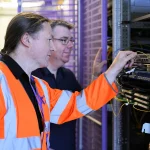The 2018 Impact of Full to Capacity FTTC Fibre Broadband Cabinets UPDATE
A new study has estimated that around 4.1% of premises in the United Kingdom are likely to be affected by full to capacity FTTC (VDSL2) based “fibre broadband” street cabinets on Openreach’s (BT) network, which is up from 3% last year. Related premises may be unable to order the faster ISP service.
Back in 2016 we ran a special article on the subject of “full” street cabinets and their impact upon consumers (here), which helped to explain why such cabinets fill up, the problems that it can cause and how long it can take to resolve via upgrades (i.e. anything from a few weeks for a simple line card change to several months or possibly longer if additional civil engineering is required).
During that same year we understood that around 2,000 of the then 77,000 live VDSL2 street cabinets were full and awaiting an upgrade. As it happens we’ve recently been discussing this issue with ISPs and in March 2018 they informed us that Openreach’s official figure was around 3% for cabinets stuck on a waiting list, which seems about normal.
Advertisement
Today Thinkbroadband has run the data (see their website for the full table) and predicted that the number of cabinets affected by this issue could be over 2,200 (the installed base will no doubt now be well over 80K). In terms of impact, around 89.6% of the UK can currently order a superfast broadband (30Mbps+) service via Openreach’s network (excluding other networks) but this coverage drops by -4.1% points due to full cabinets (-2.6% if you include all other networks).
Superfast Broadband Coverage – The impact of cabinets that are at a capacity limit
| Standard Coverage Figures | Change Due to Capacity Limits | |||||
|---|---|---|---|---|---|---|
| Region | % 30Mbps+ (All tech) |
% Openreach Any speed |
% Openreach 30Mbps+ | 30Mbps+ (All tech) | Openreach Any Speed | Openreach 30Mbps+ |
| United Kingdom | 94.8 | 92.6 | 89.6 | -2.6 | -4.1 | -4.1 |
| London | 96.8 | 91.2 | 90.1 | -1.7 | -4.1 | -4 |
| Northern Ireland | 86.3 | 96.8 | 84 | -2.3 | -2 | -2.5 |
| Scotland | 93.3 | 91.8 | 88 | -4.2 | -5.2 | -4.9 |
| Wales | 94.1 | 96 | 92.7 | -2.8 | -3.8 | -3.6 |
We should point out that TBB’s data only considers the impact of capacity on Openreach’s national network and not that of other platforms. Different networks handle different types of capacity issues in different ways and not all are as transparent about such issues.
Unfortunately if you happen to live in such an area then this can cause a lot of frustration when attempting to order a new Fibre-to-the-Cabinet (FTTC / VDSL2) based broadband package or migrate your service, particularly if the ISP accepts the order and begins the switch only to later tell you that they cannot complete it.
Advertisement
Openreach and ISPs have got better at reporting when cabinets are stuck in the waiting queue for new capacity but support staff don’t always correctly reflect this to new customers. On top of that there remains a lot of uncertainty over the question of how long consumers will have to wait before the issue is resolved.
The new G.fast service, which works in a similar way to VDSL2 but is instead installed in special pods that sit on the side of existing PCP cabinets (these are different from the VDSL cabinets), may in the near future add another complication to these figures.
An Openreach Spokesperson told ISPreview.co.uk:
“Around 97% of our cabinets are currently open to new orders and we have a dedicated team proactively monitoring take-up across all of our fibre cabinets.
On a small number of occasions, cabinets reach capacity before we can upgrade them. Solutions can range from the installation of a line card through to the build of a brand new cabinet.
We’re obviously keen to avoid any frustration for people trying to upgrade their broadband and working hard to forecast capacity demand and resolve any issues as quickly as possible.”
It’s worth pointing out that if Openreach has to build a new cabinet from scratch then that isn’t just a problem of hardware and labour cost. Complex delays can also stem from the need to seek planning permission, road access, wayleave agreements, power supply requirements and so forth.
In addition, local demand is something that can go up as well as down, particularly if a rival network operator enters the area and steals away some of Openreach’s existing users. Installing more capacity than needed can carry an extra cost and so this is one of the reasons why big operators often prefer to scale as demand grows, rather than cater for 100% of lines from day one.
Advertisement
UPDATE 3:49pm
We’ve added a comment from Openreach above.
Mark is a professional technology writer, IT consultant and computer engineer from Dorset (England), he also founded ISPreview in 1999 and enjoys analysing the latest telecoms and broadband developments. Find me on X (Twitter), Mastodon, Facebook, BlueSky, Threads.net and Linkedin.
« Utility Warehouse Ad Banned for Misleading Best Value Mobile Claim

















































Comments are closed